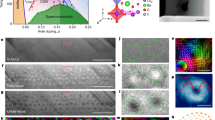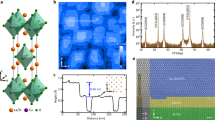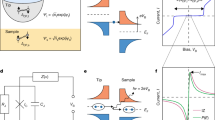Abstract
The recent discovery of superconductivity in ceramic cuprates1 continues to lead to spectacular increases in the critical temperature. Results from several neutron diffraction experiments have shown that the system YBa2Cu3O7 displays long-range order in the disposition of its oxygen vacancies, giving rise to two- and one-dimensional features in the structure2,3, which may have important electronic implications4,5. Although diffraction techniques have proved invaluable in determining the overall structure, the local structure should also be investigated on a microscopic level. Because of the relatively small scattering power of the light oxygen atoms, lattice images obtained from very thin films of the new superconductors are insensitive to the precise arrangement of the oxygen vacancies. It is known however, that due to dynamical effects, the thickness dependence of lattice images can be extremely sensitive to small effects, such as ionicity6. This can be exploited to detect the presence of long-range order in the oxygen vacancies7. Other investigators have produced experimental8 or simulated9 images, which also purport to provide evidence for the presence or detectability of order. Indications of superconductivity at very high temperatures in multiphase materials10, and the potential importance of determining the oxygen arrangement in small regions of a multiphase sample, mean that it is important to establish in detail the conditions needed for a reliable microscopic investigation of the presence of long-range order in these materials. Here we present theoretical and experimental evidence that, under a carefully chosen and controlled set of experimental parameters, it is possible to detect the presence of long-range order in the disposition of the oxygen vacancies by high-resolution transmission electron microscopy.
This is a preview of subscription content, access via your institution
Access options
Subscribe to this journal
Receive 51 print issues and online access
$199.00 per year
only $3.90 per issue
Buy this article
- Purchase on Springer Link
- Instant access to full article PDF
Prices may be subject to local taxes which are calculated during checkout
Similar content being viewed by others
References
Bednorz, J. G. & Muller, K. A. Z. Phys. B64, 189 (1986).
Capponi, J. J. et al. Europhys. Lett. 3, 1201–1308 (1987).
David, W. I. F. et al. Nature 327, 310–312 (1987).
Matthiess, L. F. & Hamann, D. R. Solid State Commun. (submitted).
Yu, J., Freeman, A. J. & Xu, J. H. Phys. Rev. Lett. 58, 1035–1037 (1987).
Anstis, G. R., Lynch, D. F., Moodie, A. F. & O'Keefe, M. A. Acta crystallogr. A29, 138–147 (1973).
Ourmazd, A. et al. Nature 327, 308–310 (1987).
Shaw, T. Physics Today 40, 17 (1987).
Hewat, E. A. et al. Nature 327, 400 (1987).
Ovshinsky, S. R. et al. Phys. Rev. Lett. 58, 2579–2581 (1987).
O'Keefe, M. A., Busek, P. R. & Iijima, S. Nature 274, 322–324 (1978).
Author information
Authors and Affiliations
Rights and permissions
About this article
Cite this article
Ourmazd, A., Spence, J. Detection of oxygen ordering in superconducting cuprates. Nature 329, 425–427 (1987). https://doi.org/10.1038/329425a0
Received:
Accepted:
Issue Date:
DOI: https://doi.org/10.1038/329425a0
Comments
By submitting a comment you agree to abide by our Terms and Community Guidelines. If you find something abusive or that does not comply with our terms or guidelines please flag it as inappropriate.



